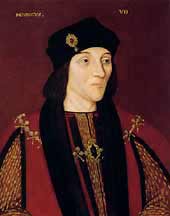 Henry VII, Tudor
Henry VII, TudorHouse of Tudor -- Reigned: 1485-1509 1457-1509
Henry descended from John of Gaunt, through the latter's illicit affair with Catherine Swynford; although he was a Lancastrian, he gained the throne through personal battle. The Lancastrian victory at the Battle of Bosworth in 1485 left Richard III slain on the field, York ambitions routed, and Henry proclaimed king. From the onset of his reign, Henry was determined to bring order to England after 85 years of civil war. His marriage to Elizabeth of York combined both the Lancaster and York factions within the Tudor line, eliminating further discord in regards to succession. He faced two insurrections during his reign, each centered around "pretenders" who claimed a closer dynastic link to the Plantagenets than Henry. Lambert Simnel posed as the Earl of Warwick, but his army was defeated and he was eventually pardoned and forced to work in the king's kitchen. Perkin Warbeck posed as Richard of York, Edward V's younger brother (and co-prisoner in the Tower of London); Warbeck's support came from the continent, and after repeated invasion attempts, Henry had him imprisoned and executed. Henry greatly strengthened the monarchy by employing many political innovations to outmaneuver the nobility. The household staff rose beyond mere servitude: Henry eschewed public appearances, therefore, staff members were the few persons Henry saw on a regular basis. He created the Committee of the Privy Council, a forerunner of the modern cabinet) as an executive advisory board; he established the Court of the Star Chamber to increase royal involvement in civil and criminal cases; and as an alternative to a revenue tax disbursement from Parliament, he imposed forced loans and grants on the nobility. Henry's mistrust of the nobility derived from his experiences in the Wars of the Roses -- a majority remained dangerously neutral until the very end. His skill at by-passing Parliament (and thus, the will of the nobility) played a crucial role in his success at renovating government. Henry's political acumen was also evident in his handling of foreign affairs. He played Spain off of France by arranging the marriage of his eldest son, Arthur, to Catherine of Aragon, daughter of Ferdinand and Isabella. Arthur died within months and Henry secured a papal dispensation for Catherine to marry Arthur's brother, the future Henry VIII. This single event had the widest-ranging effect of all Henry's actions. Henry VIII's annulment from Catherine was the impetus for the separation of the Church of England from the body of Roman Catholicism. The marriage of Henry's daughter, Margaret, to James IV of Scotland would also have later repercussions, as the marriage connected the royal families of both England and Scotland, leading the Stuarts to the throne after the extinction of the Tudor dynasty. Henry encouraged trade and commerce by subsidizing ship building and entering into lucrative trade agreements, thereby increasing the wealth of both crown and nation. Henry failed to appeal to the general populace: he maintained a distance between king and subject. He brought the nobility to heel out of necessity to transform the medieval government that he inherited into an efficient tool for conducting royal business. Law and trade replaced feudal obligation as the Middle Ages began evolving into the modern world. Francis Bacon, in his history of Henry VII, described the king:
|
All rights reserved. For details and contact information: See License Agreement, Copyright Notice. |
 Henry VII, son of Edmund Tudor and Margaret Beaufort, was born in 1457. He married Elizabeth of York in 1486, who bore him four children: Arthur, Henry, Margaret and Mary. He died in 1509 after reigning 24 years.
Henry VII, son of Edmund Tudor and Margaret Beaufort, was born in 1457. He married Elizabeth of York in 1486, who bore him four children: Arthur, Henry, Margaret and Mary. He died in 1509 after reigning 24 years.